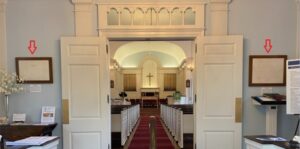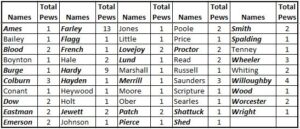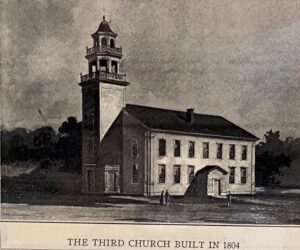By Cindy Ryherd

Inside the narthex of our beautiful Congregational Church of Hollis, on either side of the doors leading into the Sanctuary, are two framed drawings done by E.J. Colburn in 1893 (the 150th anniversary of the 1743 ordaining of the church’s first pastor, Rev. Daniel Emerson). E.J. Colburn was a Deacon of the church and a draftsman.
The two drawings are of the pew configuration on the main floor and in the gallery of the Third Meeting House (pictured below) which was erected in 1804, and they show which families owned which pews. There were 95 pews in total (68 below and 27 in the gallery).
At that time, pews were owned by parishioners, the funds used as the primary source of money to build the new church in 1804. The non-assigned pews segregated men and women: men sitting on the west side and women sitting on the east side. Similarly, men entered the Meeting House through the west entrance and women entered through the east entrance.
 If you look closely at the two drawings, you’ll see they read like a “Who’s Who” in Hollis and Brookline road names. Of the 49 family names represented in the drawings, 28 have roads named after them in one of the two towns (see table below; bold/italics are road names)!
If you look closely at the two drawings, you’ll see they read like a “Who’s Who” in Hollis and Brookline road names. Of the 49 family names represented in the drawings, 28 have roads named after them in one of the two towns (see table below; bold/italics are road names)!
The pews weren’t like today’s pews which are basically a 6’ to 7’ wooden bench with wooden back with perhaps a cushion on the bench. The pews for the 1804 church were mostly 5’ wide by 6’ long (close to square), neatly paneled and painted, with partitions between each pew. There were a few that would have been a little bigger than 5’x6x.
Inside the 5’x6’ space was 2’wide, hard, non-cushioned seats which hung on hinges attached to the wall of the pew. When a parishioner stood to pray (which they did quite often back then), the seat would be raised, and when they sat back down, it would be lowered. Elderly might have arm chairs in the pew space, and most pews had long, narrow “leaning boards” placed lengthwise in the pew in front of the occupants upon which they might rest their heads when their drowsiness got the better of their interest in the service (which would easily last two hours).
We are grateful that these two drawings were saved when the Third Meeting House burned down in 1923, and to E.J. Colburn for documenting this piece of our church history in the two drawings.

